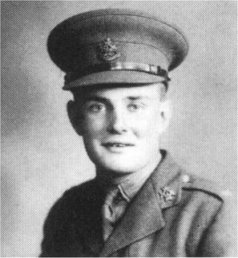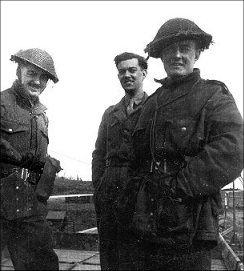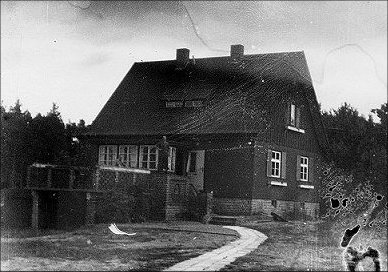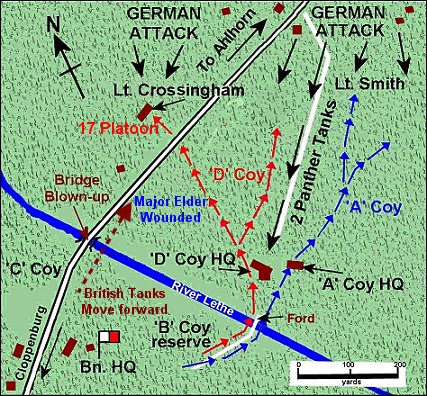Major Bryan Elder
(130065)
(Commanding ‘D’ Company)
At the start of the war Bryan Elder initially found himself as Private
soldier in the Army stationed at Maidstone with the Royal West Kent
Regiment. After only 8 weeks he moved to an Officer Training Unit (OCTU) at
Colchester. He was commissioned in to the Sherwood Foresters Regiment at
Normanton Barracks, Derby, and was then posted to the 8th Battalion in
Scotland. He then spent a period of time in Northern Ireland before
returning back to Scotland in autumn of 1942. Shortly after he went with the
Sherwood Foresters to Reykjavik, Iceland for winter training. On his return
back to England he was posted to Whittingham Barracks at Lichfield. Shortly
after he moved to Wrotham in Kent to take over the duty of Weapons Training
Officer at a Pre OCTU training centre. At the beginning of 1944 he was
appointed acting major commanding a company.

Major Bryan Elder, M.B.E., M.C.
In August 1944 as a
Reinforcement Officer he sailed from Newhaven to France, and landed at
Mulberry Harbour. He was then posted to the 1st Battalion of the
Worcestershire Regiment who had just taken heavy losses at Mount Pincon. He
arrived at St. Pierre la Vieille on the 15th August 1944 and was posted as a
Captain to be second in command of “D” Company.
On the 12th February 1945 he was awarded the Military Cross (M.C.) for his
actions in commanding ‘D’ Company during Operation Veritable.
Towards the end of the war on the 14th April 1944 the battalion was
advancing towards the river Lethe, just short of the village of Ahlhorn,
with ‘D’ Company in the lead, with Major Bryan Elder in command. During this
action Major Elder was severely wounded in the right leg.
Bryan recalls what happened:
Ahlhorn Crossroads was our next objective, and “D” Company led the advance
clearing craters and road blocks etc., until we reached the line of the
River Lethe about 2000 yards short of Ahlhorn Crossroads.
The bridge across the River
Lethe was blown up and there was no possibility of our tanks proceeding
further. However, 17
Platoon managed to wade through the River and gain a strong bridgehead in a
farmhouse area left of the bridge crater, in spite of heavy enemy fire. To
the right there was an imposing house (which turned out to be a maternity
hospital) and there was a somewhat inferior bridge for light vehicles to get
to the house. We secured the area round the house and I took a Tank Officer
to inspect the possibility of using the bridge to get a tank across the
river to support our troops. He said he would attempt to get across, and to
my relief he was successful. He took up a position at the far side of the
river whose main bridge had been blown up. We then had a bridgehead over the
River Lethe.
I remember suddenly realising that I might well have forgotten to tell the
Tank Commander that our 17 Platoon held the farmhouse to the left, so I went
to the tank to use the speaker unit on the left side of the tank and to the
rear. The next moment I was bowled over by automatic fire from down the road
from the enemy. Fortunately there was a ditch, and I lay helpless. The
bravery of the Stretcher Bearers now became apparent as they came with their
red and white flag and stretcher and carried me to the area of the maternity
home from where I was able to hand over the tricky (to say the least)
situation. To my eternal disgrace, when a lady Nurse from the maternity home
offered to dress my wounds, I told her to get back in the cellar of the
house.

Lt. K. Hill, Lt. R. Fellows and Major B. Elder
(March 1945)

The house used at Ahlhorn by ‘D’
Company
I was taken back to a field infirmary where the wounds were attended to, and
then flown back to Basingstoke to the Park Prewett Army Hospital. I managed
to get a telephone message relayed to my Wife’s Father’s garage at
Henley-on-Thames, reassuring them that I was being well attended to and not
too seriously wounded, which was just as well, as a telegram arrived from
the War Office:
“Major Bryan Elder seriously wounded, whereabouts unknown”

Attack at Ahlhorn - Major Elder wounded
I do not remember much about my first days in hospital except that I was on
a four-wheeled bed, which was shunted from one theatre to another as
required. I was obviously drowsy with drugs as they did various things and
finally got me in a “Jackson traction” with my right leg in the air
suspended at 45 degrees. My ward had some 8 or 9 wounded soldiers all with
different wounds. There was no despondency and in spite of some of the more
seriously wounded not having too much expectancy, there was no defeatism. My
Wife visited me 3 or 4 times each week travelling from Henley-on-Thames and
back, and was a great source of encouragement at all times. The Sister and
Nurses were fantastic and did all they could to encourage us to look forward
to the future.
When I had had my leg up for 10 weeks or so, I noticed a green coloured grub
on the sheets. This aroused great interest and the Specialist inspected the
same and decided that it had come from the plaster on my leg in the air. So
my plaster was duly taken off very carefully and it was covered in these
green grubs, which were hurriedly placed in large glass bottles to be used
when patients failed to react to the normal penicillin injections. My wound
was shining just like meat cleaved in a butcher’s shop, and natural skin
formed in a very short time.
About this time, my Wife came in beaming as usual, but with a little extra
glow when she produced a letter for me to read. It was an announcement that
I had been awarded the Military Cross.
I finally got out of hospital on full crutches, and able to drive, so it was
off to Heanor with my Wife, Ian our Son, and we took an unfurnished
semi-detached house at Nuthall where my Father was the Rector.

Men of 'D' Company, 1st Battalion Worcestershire Regiment (Germany 1945)
L to R: Pte. ??? (company clerk), CSM Bryan, Pte. ???, Major Bryan Elder,
Pte. Dick Pigneguey, Capt. Percy Huxter